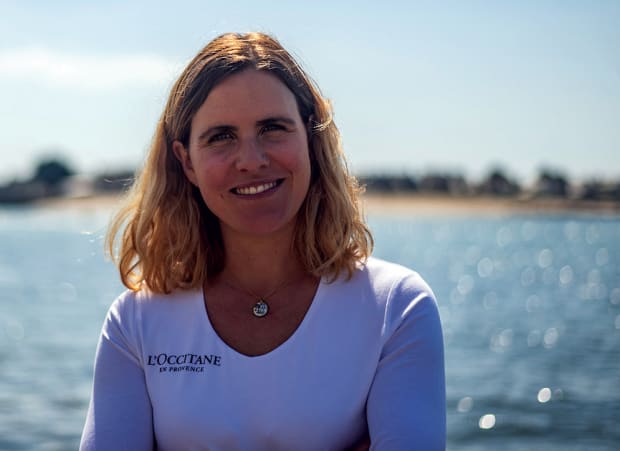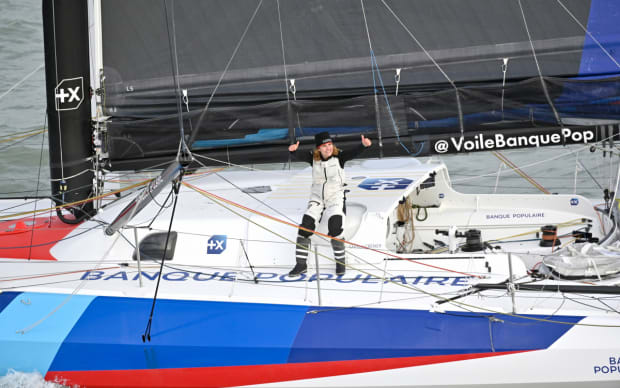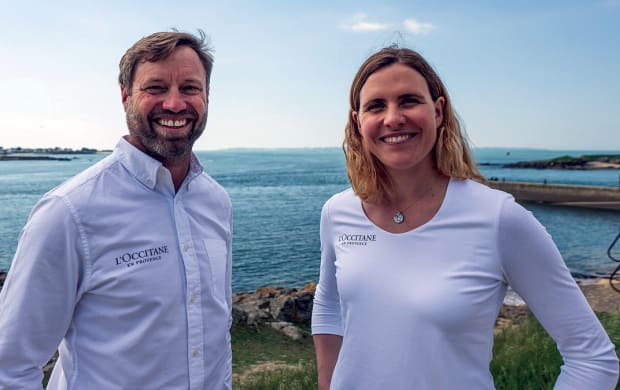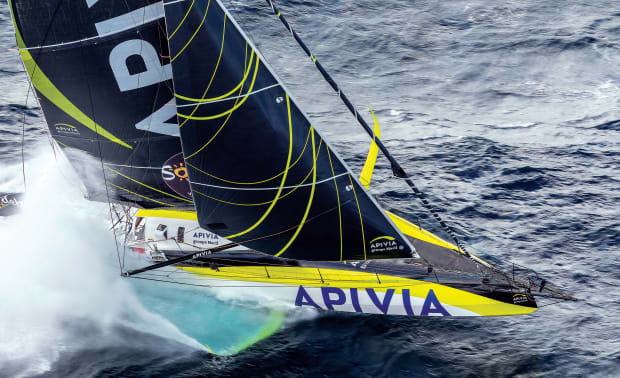
Photo courtesy of Alex Thompson Racing
In 2020, 30-year-old Clarisse Crémer set off on one of the most ambitious feats in sailing—the Vendée Globe. Alongside 32 other competitors, she left Les Sables-d’Olonne to race around the planet alone without stopping on a 60-foot monohull. Among the fleet were some of the greatest offshore solo racers of the modern era: Alex Thomson, Sam Davies, Jérémie Beyou, and Kevin Escoffier just to name a few. Of the 33 competitors, only 25 finished.
As the field winnowed down, Crémer held fast. For nearly three months, she fought to finish, ultimately setting a new course record for female competitors at 87 days, 2 hours, 24 minutes, and 25 seconds. The record had been in place for 20 years, since Ellen MacArthur’s historic 2001 second-place finish. A 12th-place finish was enough for Crémer to beat her pace by more than a week.
“I have had the Vendée Globe 2024 in mind since I last rounded the Cape of Good Hope [during the 2020 edition],” Crémer recalls. Shortly after completing the race, she secured the continuation of her 2020 sponsorship with Banque Populaire. Preparations for the next campaign began.

Photo: Olivier Blanchet/Alea #VG2020
Meanwhile, another milestone was right around the corner for the young sailor. Crémer and her partner, Tanguy Le Turquais, welcomed their first child, a daughter, in November of 2022.
Then, early this year, Crémer suddenly announced that Banque Populaire had dropped its sponsorship. With the next edition of the race a year and a half away, she was not on track to meet the qualifying mileage requirements because of the time she needed to take off to have her baby. “The Vendée Globe rules for the 2024 edition require all skippers to qualify based on miles raced. On this note, I of course fell behind the other competitors at the start, as maternity left me out of qualifying for a year,” Crémer said in a post to her social media followers.
In previous editions, finishing the race would automatically qualify a sailor for the next edition. However, for 2024 the race organization announced that new selection criteria would be put in place if more than 40 skippers registered for the event, including mileage requirements in specific events to qualify.
In a statement explaining its decision to drop Crémer, Banque Populaire said that despite attempts to get an exemption for Crémer, the race organization insisted they could not bend the rules for individual sailors. “Determined to take the start of the race alongside her in 2024, several solutions have been proposed by Team Banque Populaire to the organizer so that the regulations take into account the situation of women in the Vendée Globe and the question of maternity. All these proposals, as well as the requests for the allocation of a wildcard guarantee, have been rejected.”
The race organization responded, saying that with an ever-growing roster of skippers interested in competing, they had to put restrictions on who could enter: “In order to preserve the fairness of all the candidates for the next Vendée Globe, the Race Organization cannot under any circumstances allow itself to change the rules when the selection process has already begun.”
The selection rule was based on the proposals voted on by the IMOCA Class in August 2020. In attempting to create fair conditions to put Vendée hopefuls on equal footing, they’d inadvertently created a rule that sank one proven young woman’s campaign before it even started.

Photo courtesy of Alex Thomson Racing
The international outcry was immediate. Sailors and fans on both sides of the Atlantic condemned Banque Populaire’s decision and the race organization’s stringent requirements that had the effect of penalizing female sailors for taking maternity leave.
“The rules of a competition are supposed to ensure fairness and sportsmanship,” Crémer said. “Today, the rules chosen by the Vendée Globe prohibit a woman from having a child, even if she is a well-known athlete who has already finished in the previous edition. In the 21st century, who would believe that such rules are fair?”
In the world of offshore pro racing, campaigns live and die by the whims of sponsors. For female sailors, this has long been a barrier endemic to professional yacht racing. Who could forget Tracy Edwards’ 1989 Whitbread campaign being denied sponsorship because no one wanted to put their branding on an effort that was expected to at best fail, and at worst result in the untimely deaths of 12 young women?

Photo courtesy of Jean-Marie Liot/Alea/Disobey/Apivia
Fortunately, just under three months after Crémer announced that she would not be competing in the 2024 Vendée Globe, there was happy news. L’OCCITANE en Provence, a French luxury beauty brand, had signed on as the new title sponsor.
“We have decided to join forces to promote women’s leadership in sailing, a competitive world that is still largely male. Indeed, we make it a point of honor to support all women in their personal and professional projects,” says Adrien Geiger, managing director of L’OCCITANE en Provence.
They’ve also secured the IMOCA 60 formerly known as Apivia for her campaign. This hull took line honors in the 2020-21 Vendée Globe while skippered by Charlie Dalin, making it one of the most acclaimed designs of its generation. And if that weren’t enough reason to be optimistic, Crémer also announced a new mentor in British ocean racer Alex Thomson, who saw the Vendée podium twice before retiring to advise other campaigns.
“Clarisse is one of the most talented sailors in ocean racing, and she deserves to be at the start of the Vendée Globe next year,” said Thomson. “We want to prove to the world that becoming a mother doesn’t change who you are as an athlete. [My team and I] intend to provide Clarisse with all the tools that will enable her to compete with equity.”
Though the experience has been difficult, Crémer says she’s grateful for all the support and focused on the future. “It’s a great joy to have an extraordinary boat and a great team to accompany me in this adventure, and I can’t wait to get back to sailing.”
And now—with under 20 months to reassemble her team, test and reequip the new boat, and train for the long months at sea—it’s a race to the start.
June/July 2023








